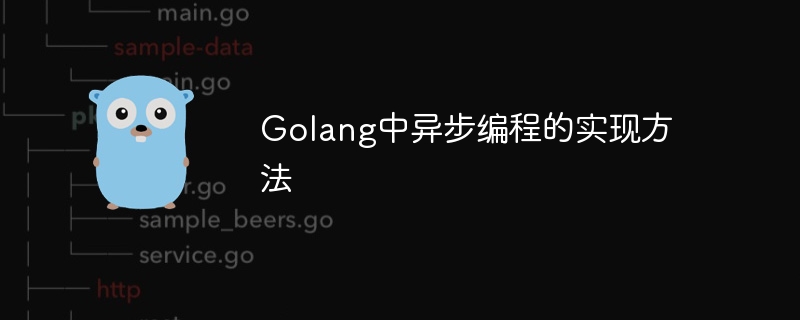Home >Backend Development >Golang >How to implement asynchronous programming in Golang
How to implement asynchronous programming in Golang
- WBOYWBOYWBOYWBOYWBOYWBOYWBOYWBOYWBOYWBOYWBOYWBOYWBOriginal
- 2024-02-29 09:36:041097browse

How to implement asynchronous programming in Golang
In Golang, asynchronous programming is implemented through goroutine and channel. Goroutine is a lightweight thread that can execute tasks concurrently. The channel is a communication pipe between goroutines, which can realize data transfer and synchronization operations. Through the combination of goroutine and channel, efficient asynchronous programming can be achieved.
Now we will introduce in detail how to perform asynchronous programming in Golang, and attach code examples.
1. Using goroutine
In Golang, we can use the keyword go to create a goroutine. The sample code is as follows:
package main
import (
"fmt"
"time"
)
func main() {
// 启动一个goroutine
go func() {
for i := 0; i < 5; i++ {
fmt.Println("Hello from goroutine")
time.Sleep(1 * time.Second)
}
}()
fmt.Println("Hello from main goroutine")
// 主goroutine休眠10秒,确保子goroutine有足够时间执行完毕
time.Sleep(10 * time.Second)
} above In the example, we started a goroutine through go func(), and printed "Hello from goroutine" 5 times in the goroutine, with an interval of 1 second each time. At the same time, "Hello from main goroutine" is printed in the main goroutine. By observing the output results, you can see that the two goroutines are executed concurrently.
2. Use channel for communication
In asynchronous programming, data transfer and synchronization operations are usually required between goroutines. You can use channels at this time. The following is an example of using channels for communication:
package main
import (
"fmt"
)
func main() {
// 创建一个字符串类型的channel
messages := make(chan string)
// 启动一个goroutine,向channel发送数据
go func() {
messages <- "Hello from goroutine"
}()
// 主goroutine从channel接收数据并打印
msg := <-messages
fmt.Println(msg)
}In the above example, we created a string type channelmessages and sent a message to the channel in the goroutine . The main goroutine receives messages from the channel through and prints them out.
3. Use select to achieve non-blocking communication
In asynchronous programming, sometimes we need to process data from multiple channels. At this time, we can use the select statement to achieve this. Non-blocking communication. Here is an example using select:
package main
import (
"fmt"
"time"
)
func main() {
// 创建两个字符串类型的channel
channel1 := make(chan string)
channel2 := make(chan string)
// 启动两个goroutine,分别向两个channel发送消息
go func() {
time.Sleep(1 * time.Second)
channel1 <- "Message from channel1"
}()
go func() {
time.Sleep(2 * time.Second)
channel2 <- "Message from channel2"
}()
// 使用select语句处理多个channel数据
for i := 0; i < 2; i++ {
select {
case msg1 := <-channel1:
fmt.Println(msg1)
case msg2 := <-channel2:
fmt.Println(msg2)
}
}
} In the above example, we have created two string type channels channel1 and channel2, messages were sent to two channels respectively. Then the data of the two channels are processed simultaneously through the select statement to ensure the implementation of non-blocking communication.
Conclusion
Through the above examples, we understand how to use goroutine and channel to implement asynchronous programming in Golang. The concurrent execution of tasks is realized through goroutine, the transmission and synchronization of data are realized through channels, and the non-blocking communication of multiple channels is realized through select. In actual development, rational use of goroutine and channel can improve the concurrency performance and efficiency of the program.
The above is the detailed content of How to implement asynchronous programming in Golang. For more information, please follow other related articles on the PHP Chinese website!

